What You Need to Know About Soil and Plant Scientist
Soil & Plant Scientist Job Description Conduct research in breeding, physiology, production, yield, and management of crops and agricultural plants or trees, shrubs, and nursery stock, their growth in soils, and control of pests; or study the chemical, physical, biological, and mineralogical composition of soils as they relate to plant or crop growth. May classify and map soils and investigate effects of alternative practices on soil and crop productivity.
Soil & Plant Scientist Responsibilities
- Plan or supervise waste management programs for composting or farming.
- Conduct experiments investigating how soil forms, changes, or interacts with land-based ecosystems or living organisms.
- Consult with engineers or other technical personnel working on construction projects about the effects of soil problems and possible solutions to these problems.
- Investigate responses of soils to specific management practices to determine the use capabilities of soils and the effects of alternative practices on soil productivity.
- Plan or supervise land conservation or reclamation programs for industrial development projects.
- Conduct experiments to develop new or improved varieties of field crops, focusing on characteristics such as yield, quality, disease resistance, nutritional value, or adaptation to specific soils or climates.
Featured schools near , edit
Things a Soil & Plant Scientist Should Know How to Do
Soil and Plant Scientists state the following job skills are important in their day-to-day work.
Reading Comprehension: Understanding written sentences and paragraphs in work related documents.
Science: Using scientific rules and methods to solve problems.
Active Learning: Understanding the implications of new information for both current and future problem-solving and decision-making.
Speaking: Talking to others to convey information effectively.
Complex Problem Solving: Identifying complex problems and reviewing related information to develop and evaluate options and implement solutions.
Critical Thinking: Using logic and reasoning to identify the strengths and weaknesses of alternative solutions, conclusions or approaches to problems.
Types of Soil and Plant Scientist
- Pomologist
- Extension Specialist
- Crop Nutrition Scientist
- Arborist
- Corn Breeder
Are There Job Opportunities for Soil and Plant Scientists?
In the United States, there were 19,900 jobs for Soil and Plant Scientist in 2016. New jobs are being produced at a rate of 9% which is above the national average. The Bureau of Labor Statistics predicts 1,800 new jobs for Soil and Plant Scientist by 2026. There will be an estimated 2,200 positions for Soil & Plant Scientist per year.
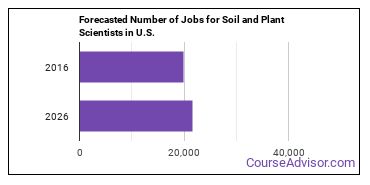
The states with the most job growth for Soil & Plant Scientist are Nevada, Kansas, and North Carolina. Watch out if you plan on working in Alaska, Wyoming, or Oklahoma. These states have the worst job growth for this type of profession.
Average Soil and Plant Scientists Salary
The typical yearly salary for Soil and Plant Scientists is somewhere between $38,570 and $115,400.
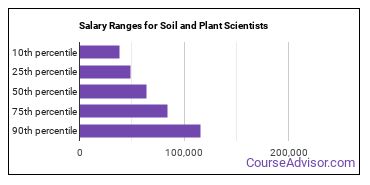
Soil and Plant Scientists who work in Maryland, Massachusetts, or District of Columbia, make the highest salaries.
How much do Soil and Plant Scientists make in different U.S. states?
| State | Annual Mean Salary |
|---|---|
| Alabama | $63,130 |
| Alaska | $69,210 |
| Arizona | $74,420 |
| Arkansas | $75,440 |
| California | $80,710 |
| Colorado | $56,990 |
| Connecticut | $85,210 |
| Delaware | $56,870 |
| District of Columbia | $88,840 |
| Florida | $64,230 |
| Georgia | $65,820 |
| Hawaii | $68,550 |
| Idaho | $70,940 |
| Illinois | $58,950 |
| Indiana | $59,850 |
| Iowa | $79,650 |
| Kansas | $57,260 |
| Kentucky | $67,690 |
| Louisiana | $68,100 |
| Maine | $60,630 |
| Maryland | $98,880 |
| Massachusetts | $86,160 |
| Michigan | $54,800 |
| Minnesota | $74,130 |
| Mississippi | $90,700 |
| Missouri | $53,030 |
| Montana | $65,010 |
| Nebraska | $57,320 |
| Nevada | $71,490 |
| New Jersey | $71,730 |
| New Mexico | $57,840 |
| New York | $83,530 |
| North Carolina | $72,890 |
| North Dakota | $75,800 |
| Ohio | $56,220 |
| Oklahoma | $42,430 |
| Oregon | $69,210 |
| Pennsylvania | $66,440 |
| South Dakota | $59,200 |
| Tennessee | $56,980 |
| Texas | $68,150 |
| Utah | $59,590 |
| Virginia | $68,660 |
| Washington | $72,660 |
| West Virginia | $53,950 |
| Wisconsin | $59,560 |
What Tools & Technology do Soil and Plant Scientists Use?
Although they’re not necessarily needed for all jobs, the following technologies are used by many Soil and Plant Scientists:
- Microsoft Excel
- Microsoft Word
- Microsoft Office
- Microsoft PowerPoint
- Microsoft Access
- Word processing software
- Autodesk AutoCAD
- SAS
- IBM SPSS Statistics
- R
- Geographic information system GIS software
- Microsoft Active Server Pages ASP
- Leica Geosystems ERDAS IMAGINE
- STATISTICA
- ESRI ArcGIS software
- GAEA Technologies WinSieve
- SoilVision Systems SVOFFICE
Becoming a Soil & Plant Scientist
Individuals working as a Soil and Plant Scientist have obtained the following education levels:

What work experience do I need to become a Soil & Plant Scientist?
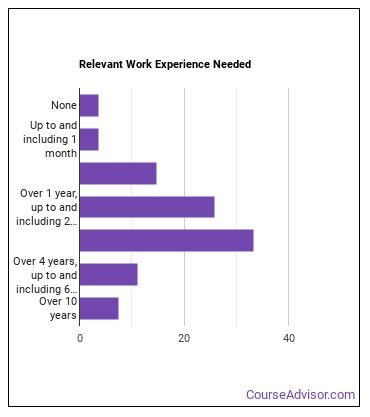
Soil and Plant Scientists Sector
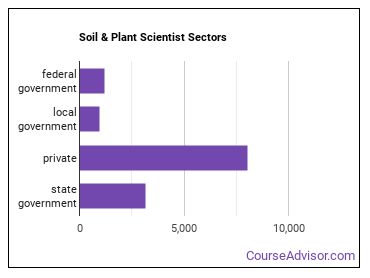
Below are examples of industries where Soil and Plant Scientists work:
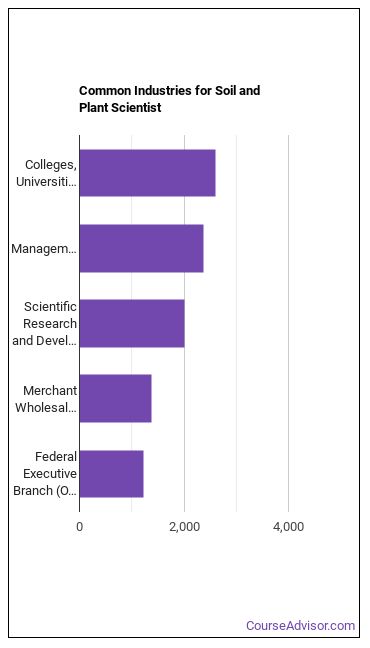
Other Jobs You May be Interested In
Career changers with experience as a Soil and Plant Scientist sometimes find work in one of the following fields:
References:
Image Credit: W.carter via Creative Commons CC0 1.0 Universal Public Domain Dedication
More about our data sources and methodologies.
Featured Schools
 Request Info
Request Info
|
Southern New Hampshire University You have goals. Southern New Hampshire University can help you get there. Whether you need a bachelor's degree to get into a career or want a master's degree to move up in your current career, SNHU has an online program for you. Find your degree from over 200 online programs. Learn More > |
